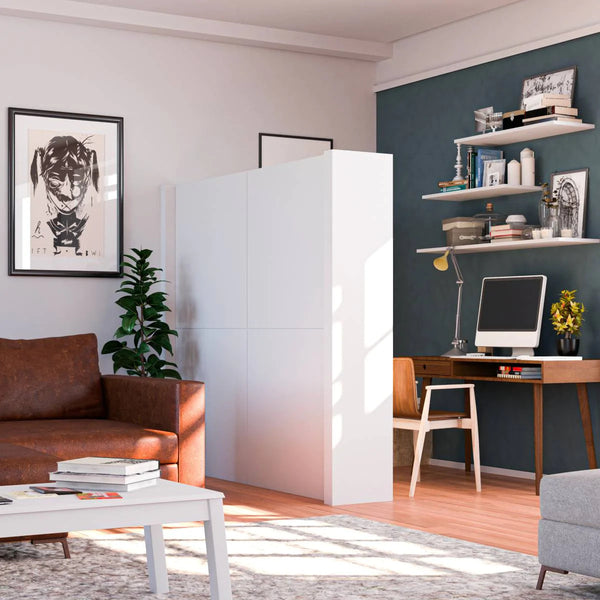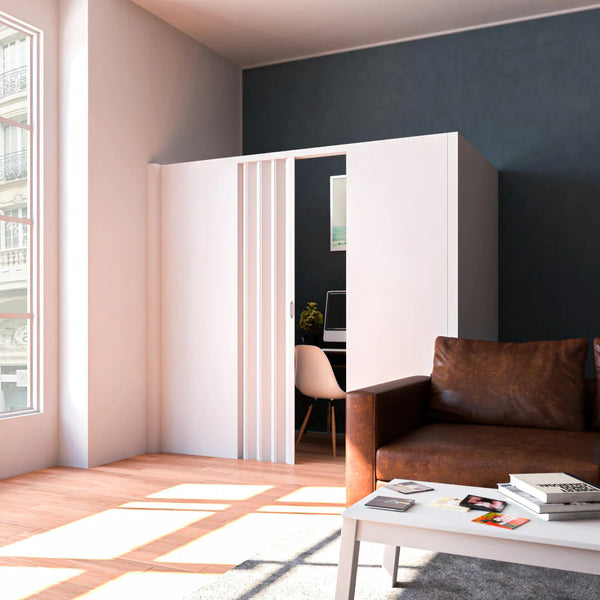Your Home Office Size Guide for a Productive Work-From-Home Setup

There was a time when the home office was a thing reserved for freelancers and hobbyists, while the rest of us had to deal with the daily commute to the office. The pandemic, however, imposed the work-from-home on everyone, making it an intrinsic part of the work culture.
Work-from-home is here to stay. Even though offices have reopened, most companies have incorporated partial remote working. Many have even shifted to fully remote work setups. So naturally, the home office is now an essential element in every home.
Creating a home office can be crucial in defining your work efficiency, productivity, and creativity. If you’re in the process of setting up one for yourself but don’t know how to go about it, this home office size guide is for you.
We’ve put together several home office types and layouts with varying requirements, along with smart and innovative space solutions (many offered by our temporary, modular, DIY partitions and room dividers!) to make this process easier for you.
What are the different types of home office setups?
1. Dedicated Room as a Home Office
The standard size for a dedicated home office is between 70 and 150sqft. The starting size of 70sqft is typically enough to house a comfortably-sized desk and chair, as well as a decent amount of storage.
The larger sizes of 120-150sqft are also enough for a couple of extra chairs or a sofa for meetings, additional equipment like printers, and activities like drawing and painting.
Here are some layout examples of the standard-sized home office:

2. A Portion of a Room Converted Into a Home Office
While it’s great to have an entire room dedicated to the home office, most of us have to make do with just a part of a room, like the living room or a bedroom. You’ll agree if you live in an area where rents are expensive, where even a 150sqft studio is a struggle to afford. Also, if you shifted to a partial work-from-home scenario after the pandemic, it probably wouldn’t make sense to give up so much of your home space to a home office.

When it comes to makeshift or temporary home offices, a million options are possible! Your setup could range from a simple work desk in your living/bedroom, to a temporary divider marking your work area, to a fully defined workstation or work booth.

With a nice corner or end of a room, you can quickly assemble a modular DIY partition wall to cordon off your work zone from distracting elements of the house (aka partners, roommates, kids, pets, etc.).
Here are some common home office setups using temporary walls and dividers in a room:


3. Other Creative Space Solutions to Home Office Setups
If you don’t have a corner or portion of a room to spare, there might just be other options to your rescue. You can use up the space under a flight of stairs where the height rises beyond 3’ and set up your work station.

As an alternative, you can also place a narrow table of 20-22” (sufficient for a laptop) inside a cabinet with the doors acting as the wings of your workstation. When done, simply shut the cabinet doors and your home office will disappear- get the work out of sight and out of mind!

4. Home Office For 2
Living and working out of the same home as a couple can be challenging but if it must be done, here are some layout ideas showing minimum spaces. Adjust them based on how much space you have available and what your work requirements

What To Consider While Setting Up Your Home Office
1. Visual and sound privacy
Privacy can become crucial if your home office is a part of a living or bedroom, especially if there are distractions from other people and activities around you that might hamper productivity. A room divider can help create a visual barrier to separate and define your workspace. For more definition and privacy, consider building a work booth or cubicle with a door.

2. Desk And Chair Size
Your work desk is the single most important factor that defines your home office. Consider what your work essentials are to decide on the size of your desk. If you work mostly on a laptop and nothing else, a 4’ x 2’ standard desk is ideal.
However, smaller desks of 3’x 2’ or 3’x 1’6” could work in tighter spaces. When you must absolutely squeeze, a 2’ x 1’6” desk may also do the job (and let you do yours).
If you need a laptop plus a screen, consider a 4’x 2’6” table for comfortable working, although a 4’x2’ would also do if it must.

If you’re in the creative field, it might be worth getting a larger executive desk of 5’ x 2’6” or even a 6’ x 2’6” to allow for some space to write, doodle, sketch, and design too.
Don’t forget your chair! Comfortable office swivel chairs can take up quite some space – they’re usually 2’-2’6” wide and 2’ deep. If you’re working from home only partially and you don’t have much space to spare, consider a stool or dining chair which is roughly 15”x15”.
3. Storage And Equipment
Consider space for the storage of files, books, papers and stationery that you might need handy while working. You may even need equipment like printers, desk lamps, etc. that can take up some space. Allocating storage space can get tricky if you’re already tight on the desk space. Consider different options like under-desk storage, file cabinets, and wall shelves.
4. Work activities
Your work may not solely revolve around the computer. A designer may need space to doodle, think, and sketch as an essential element in their work process. An artist probably needs space to spread out with their work. An executive would require space for meeting people. If your work involves a fair bit of thinking, it might even be worthwhile allowing some space for a sofa or an armchair.

To Conclude
Creating that perfect work environment to encourage your productivity and efficiency can be tricky when bound by space and budget restrictions. However, we hope that this size guide and the different examples of home office layouts will spark that creativity and help you get on with the task right away!
Can’t seem to be able to decide on the perfect home office setup for you? Want to build a workstation with temporary walls but not sure about the size or layout? Reach out to us - our space design experts will help you come up with a solution that fits your specific needs perfectly!

